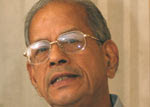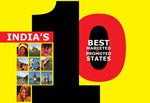When IIPM comes to education, never compromiseAmitabh Bachchan was the last Bollywood superstar who tried to cash in on his star status to build a business empire. King Khan is trying to move much beyond that! By ADITI PRASAD
Late

in the 1980s, he burst upon the scene as a gawking teenager in the serial Fauji. Most girls and women loved him; as did some men. Then he arrived in Bollywood as the character Raju who becomes a gentleman – losing his soul for money and greed before redeeming himself. Then he was the successful tycoon in Kabhi Khushi Kabhi Gam. Reel life often mirrors real life, and fantasies often come true. And so you have superstar Shah Rukh Khan in a new role – a can do and aggressive entrepreneur who has global ambitions.
Who would have known that behind the carelessly crafted façade of an entertainer who takes dancing at weddings in his stride, lies the limitless energy and entrepreneurial fire that perhaps only a very few in a million possess. A multi-million dollar deal with the Indian Premier League (IPL), a stake in BAG Films’ entertainment foray, a place on the board of Jet Airways, besides his billion dollar ambitions with Red Chillies Entertainment and VFX, SRK has certainly hedged his bets in the cyclical Hindi film industry.
Even as contemporaries like Aamir Khan, Saif Ali Khan and Sunil Shetty are content with floating production houses or launching restaurant chains, as potential retirement plans; SRK has readied himself with a battery of business interests, to launch himself in style alongside the who’s who of India Inc. And his timing is just perfect. Sources opine that the King will continue to proudly flaunt the Bollywood crown for maximum two to four years and Shah Rukh is leaving no stone unturned to make the most of his precious place under the vacillating Bollywood Sun.
Lalit Modi, the suave Chairman of IPL is a sure-shot convert to the growing fan-list of SRK’s business prowess. “In my view, Shah Rukh is the world’s biggest and best marketer,” he exclaims, recounting a recent incident that re-affirmed his faith in SRK’s business acumen. “I met Shah Rukh within a week of his purchasing the Kolkata franchise of IPL. You won’t believe it, but he had already prepared nearly 20 power point presentations that covered the entire gamut – from possible mascots, to team uniforms, to marketing presentations, possible sponsors. He was like a man possessed,” avers Modi. According to Modi, soon after buying the Kolkata team, Shah Rukh had locked himself in at Mannat (his home in Mumbai) for a week to study the game of cricket and to chart out his team’s future direction.
Soumitra Karnik, VP & Executive Creative Director, JWT is also bowled over. “Shah Rukh’s vision for the team is fantastic. The kind of presentations that he had prepared on IPL, were far better than any MBA student could ever have made,” he points out, confident that in years to come, SRK would completely re-define entertainment and sports in India. And Soumitra should know. Having directed SRK in a series of Pepsi commercials, the creative brain has had a fair share of interactions with Shah Rukh the showman turned marketer and business visionary.
For the uninitiated, King Khan bagged the Kolkata franchise of IPL a few months ago - for an estimated $75 million - under the banner of a new sports and games division created under his production company Red Chillies Entertainment. At the time, SRK’s detractors said that playing hockey in college and playing a star coach on-screen for a hockey team (Chak De India) is no claim to fame in the actual world of sports, but Shah Rukh’s keen business vision, is already proving naysayers wrong.
Sources in BCCI affirm that potential sponsors have begun knocking avidly at SRK’s doors for piggybacking his charisma on the cricket field. No surprise here, given that most of the other IPL franchises are biggies of India Inc. (a la Mukesh Ambani, Vijay Mallya & N. Srinivasan), with their own companies & brands to support. SRK’s decision to move in for an IPL franchise has, in fact, put him in the league of these business barons who share the IPL franchise tag along with Shah Rukh.
At the recently concluded IPL auction for players in Mumbai, a blue T-shirt and jeans clad SRK turned up to full house, and sauntered off with stars like Ricky Ponting, Brendon McCullum, Shoaib Akhtar, Chris Gayle, David Hussey, among others in his pocket, from right under the noses of these biz biggies. Of course, although SRK had bid for Dhoni originally, in the final assessment, he gave Dhoni the miss. And rightly so, given that Dhoni went under the hammer for an eye-popping $1.5 million.
The nation’s passion for anything cricket, coupled with SRK’s deft marketing manoeuvres, his entertainment jugglery and his unbridled charisma to pull fans into the stadium, is just waiting to set the cash registers ringing for King Khan. “I expect all IPL teams to be worth $700-800 million within 5 years of operations,” avers Modi. But so confident is Modi about Shah Rukh’s ability to make a success out of his IPL foray that he candidly admits: “Of the existing franchises, I expect SRK’s Kolkata franchise to be the first to break even and recover money, and that too within the very first year of operations itself.”
The reason is not too far off the horizon: Shah Rukh’s team offers the best of both world’s to fans – Bollywood and Cricket – and no wonder marketers are clamouring to hop on to SRK’s Kolkata bandwagon. Of course, Preity Zinta, who has bagged rights for the Mohali IPL team (with Ness Wadia), trails a similar route, but her charisma pales beside Shah Rukh’s in-your face star appeal.
What’s more, SRK has no intentions to stop with cricket. He wants to invest his time and money in other sports too, just that “starting with cricket makes more business sense,” says the Badshah of Bollywood himself. The vision is to move onto hockey and eventually football. “If you want to make a particular sport popular in the country, you need to make it sensible, business-wise,” affirms the King Khan.
Cricket is not the only business foray that Shah Rukh is eyeing. Being India’s ruling entertainment czar, where his very touch has the ability to transform the fortunes of a Bollywood flick, a television show or even an on-stage performance, SRK is raking in enough moolah for himself as an actor and entertainer-par-excellence. But the man, who likes to be in the driving seat, was not content with that. He kept hinting to his friends in the industry about his latent entrepreneurial fire. “He used to keep telling me, “I’m damn good at business’,” says Director, Aziz Mirza. And true to his ambition, he made his debut as a businessman in 1999 with his production company Dreamz Unlimited, along with friend Juhi Chawla and Aziz Mirza. The first film under this banner – Phir Bhi Dil Hai Hindustani – did not do very well. So, he dreamed up the big-budget Asoka, under Arclightz and Films, SRK’s second production banner.
When

Asoka also bombed, SRK conceived Red Chillies Entertainment (this time with wife Gauri Khan), and launched friend and Choreographer, Farah Khan as Director in 2004, with Main Hoon Na. The film was successful at the box office and ever since Red Chillies Entertainment has become his main production company. The latest flick under the Red Chillies banner has been the hugely successful Om Shanti Om, which according to Box Office Mojo has grossed $36,410,328 globally (as on February 7th, 2008), becoming the industry’s biggest grosser ever. Expectedly, the marketer in SRK pulled all stops to promote the film globally and in India, tying up with leading global distributors Eros International, and even making a controversial appearance at the T-20 World Cup in S. Africa, dressed conveniently in an OSO T-shirt. In as much, the first generation producer has successfully taken on the established Sony and Columbia banners. When awarded the entertainment business leader award last year, SRK said: “They may have big budgets, big banners, but I have Shah Rukh Khan.”
SRK’s ambitions are rocketing sky high with the latent potential for Red Chillies Entertainment. The latest thing on the production house’s hand is a flurry of entertainment-oriented news programming to be produced for BAG Films’ entertainment news channel – E24 – to be launched in March 2008. The deal has its base in the 10% stake that King Khan bought in Anuradha Prasad’s BAG Glamour earlier this year, a subsidiary of BAG Films & Media, for about Rs.10 crore. Here too, SRK made a detailed study of the business prospects and the revenue model of the proposed channel, before betting his energies in this venture.
The other big slice on SRK’s plate is an offshoot of his entertainment company - Red Chillies VFX. Managed by the supervision trio of Arjun Mitra, Haresh Hingorani & Keitan Yadav, Red Chillies VFX is all about creating and nurturing visual effects for feature movies as well as advertisements. Given the pace at which Bollywood is expanding and when big budget movies are more the rule than the exception, the technology edge of VFX is definitely brimming with potential. Small wonder that Red Chillies VFX has been hived off as a separate business unit. The bid is to not just pick up work of home productions, but to also work with other banners. Started nearly a year and a half ago, Om Shanti Om was the last home production that the VFX team worked on, while Jhoom Barabar Jhoom, Honeymoon Travels & Don have been key outside productions. “Our business proposition is exceedingly promising. We’re among the top three VFX studio’s in India and hope to become the topmost in few years. At Red Chillies, we are not going so much for numbers as for quality,” says Arjun Mitra of Red Chillies VFX, even as he takes a breather during a shoot for Nagesh Kuknoor’s movie, in Mumbai’s Kamalistan Studio.
Hollywood is next on Shah Rukh’s VFX roadmap and he’s busy building up capacities to meet the growing demand for his state-of-the-art VFX studio set up. And being the shrewd marketer he is, SRK recently announced his plans to produce India’s most expensive movie @ Rs.100 crore (with oodles of VFX thrown in) to showcase the strength of the subcontinent’s special effects and animation industries to world cinema. But, pertinently, the movie, if anything, will showcase the prowess of Red Chillies VFX to scores of Hollywood studios, which in turn will serve as a potential market for this initiative of SRK.
Arjun Mitra denies any plans to woo Hollywood studios as of now. “We have 70 people in the present VFX team and we need to double that just to cope with the work coming in from Bollywood,” he says. But sources say that infrastructure at Red Chillies VFX is being expanded rapidly to accommodate more assignments.
From merely Bollywood, the noose has been expanded to straddle advertising films too. The advertisement to film ratio for Red Chillies is in the ratio of 20:80, since ad assignments are restricted to brands that SRK endorses. Now, the team is keen on expanding the size of the net to rope in other brands too.
To keep pace with his growing enterprise, SRK recently shifted premises of Red Chillies VFX to Mumbai’s posh Lokhandwala area and his team just can’t stop singing his praises. “We are amazed at his quick decisions. When we asked for a bigger office, he did not hesitate a moment and despite the huge cost of real estate in Mumbai, within a week we had finalised a new place. If that’s not the sign of a good entrepreneur, I wonder what is,” gushes Arjun.
Besides, Shah Rukh is also carefully nurturing brand SRK both on and off screen. Close associates point out that Shah Rukh, in fact, is so obsessed with his brand persona, that he sometimes cannot help referring to himself in third person. Add to that his intelligence, witty remarks, a wicked sense of humour – and you have all the trappings for a media savvy, charismatic and shrewd business leader.
Incidentally, Shah Rukh is not the only Bollywood superstar who boasts having this entrepreneurial fire in his belly. Amitabh Bachchan too headed in a similar direction, but was badly scalded due to the financial mess, which his company ABCL landed itself into. Thankfully, Bachchan bounced back. Kaun Banega Crorepati gave him a new lease of life and he repaid his debts. But, the entrepreneur in him lies dormant to the day. There’s also the jumping jack of the 70s – Jeetendra – who sits as promoter in the Rs.1,515 crore Balaji Telefilms. While one would like to give him credit, he himself passes off all praise to his daughter Ekta Kapoor for the success of this production house. So, it would not be entirely wrong to say that SRK has dared to venture where no other Bollywood superstar has tread.
Over the years, this Raju has helped a host of brands acquire the Gentleman status in the Indian marketplace. Guess it’s SRK’s payback time to himself now. Albeit an unconventional one, Mr. Khan is well on his way to become another coveted gem in the glittering crown of corporate India.
With inputs from Pallavi SrivastavaFor more articles, Click on
IIPM Article.
Source :
IIPM Editorial, 2008
An Initiative of
IIPM,
Malay Chaudhuri and
Arindam chaudhuri (
Renowned Management Guru and
Economist).
Read these article :-B-schooled in India, Placed Abroad (
Print Version)
IIPM in Financial times (
Print Version)
IIPM makes business education truly globalThe Indian Institute of Planning and Management (IIPM)IIPM CampusFor More IIPM Info, Visit below mentioned IIPM articles.
IIPM, GURGAON
IIPM - Admission Procedure
IIPM is A World of Career
Why Study Abroad When IIPM Gives You 3 global Advantages!










